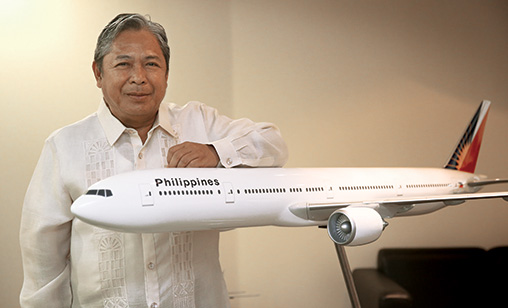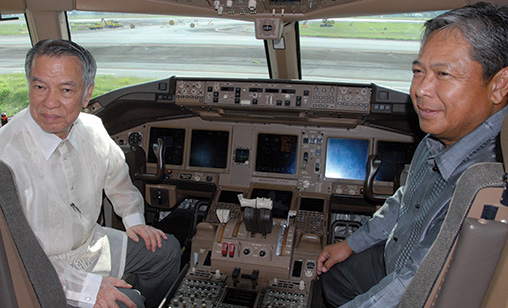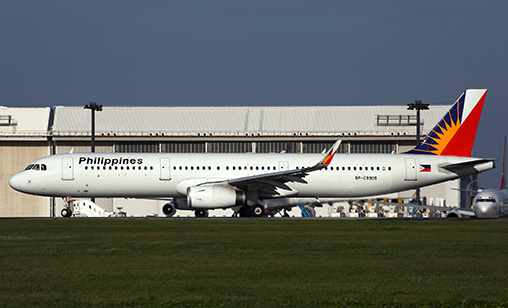Cover Story
PAL’S PILGRIMAGE TO PROFIT
Philippine Airlines (PAL), under the leadership once again of Jaime Bautista, is on the path to renewal after PAL chairman, Lucia Tan, bought back control of the carrier from brewing conglomerate, San Miguel.
March 1st 2015
At the turn of the year, PAL president, Jaime Bautista, found himself aboard one of PAL’s A340s, en route to Rome, a destination the airline does not serve. With its call sign, Shepherd One, the aircraft had taken off from Villamor Air Base in Manila with a special passenger onboard, global Catholicism’s leader, Pope Francis. Read More » The pontiff was flying home after a triumphant five-day visit to the deeply Catholic Philippines.
 |
A month later, when Bautista spoke to Orient Aviation at PAL’s headquarters in Manila, the PAL president was clearly still moved by the honor of having Pope Francis aboard PAL. Bautista, who retook the reigns of PAL last year after Tan bought out San Miguel’s holding, said it was just the morale booster the airline needed as it maps its future after almost three years under the management of the huge brewing conglomerate.
During that period, from 2012 to late 2014, Lucio Tan retained 51% of PAL and remained as chairman, but management control was held by the new shareholder, the San Miguel brewery, and its boss, Ramon Ang.
Since the management change, PAL’s performance has weakened, and not only because of the decisions made when the brewer’s management called the shots. After the first nine months of its 2013 fiscal year - annual comparisons are difficult because during this period the airline changed its financial year from the twelve months ending March 31 to the calendar year – the airline’s deficit ballooned by 332% over 2012, to $267 million. Fierce and effective competition from both domestic and regional carriers, particularly in the budget sector, had eaten into a significant chunk of PAL’s once loyal passenger base.
But Ang had also made a massive order for new aircraft that the new and present management, as well as many analysts, said was too much capacity, too soon.
More recently, the figures have improved, but Bautista, who had led PAL until management control shifted to the brewer, now faces challenges in reversing some San Miguel decisions.
Luckily for PAL, industry veteran Bautista knows the carrier inside out. Armed with this knowledge, he has slipped effortlessly into his old role at PAL and quickly laid out his objectives for a return to profit for the flag carrier.
Top of his agenda has been the renegotiation of Ang’s US$9.5 billion order for 64 new Airbus planes. The commitment meant PAL would have too much capacity arriving too quickly for market conditions. In the past two years, PAL has taken delivery of 15 A330s, 14 A321s and a Bombardier Q300. It was due to accept another 10 A321s this year and 10 more in 2016. Then, in 2017, deliveries of 14 A321 neos were scheduled to commence.
“That’s a lot of capacity,” said Bautista. In a matter of months however, he has sorted out the situation. No official announcement has been made by PAL or Airbus, but it is understood a new agreement has been signed. There will be no cancellations, but delivery of around half of the 20 A321s due to arrive in the next 48 months will be deferred for at least two years.
PAL has a fleet of 50 aircraft: six B777-300ERs, six A340-300s, 14 A330-300s, 14 A321-200s and 10 A320-200s. Its subsidiary, domestic low-cost carrier, Air Philippines, has 23 planes: 13 A320-200s, one A330-300, four Bombardier Dash 8 Q300s and five Bombardier Dash 8 Q400.
 |
PAL’s domestic market share has slipped to 40%, well behind rival, budget carrier, Cebu Pacific, with 50%.
Internationally, Bautista is focusing on long haul operations that made, or can make, money. The strategy is to boost U.S. services, while searching for a key partner in Europe, one of the airline’s operational black spots. At the same time, he is reviewing other aspects of the carrier’s business systems, workforce efficiency and its service levels, areas he believes are critical to success.
With the fleet planning issue resolved, Bautista is now taking advantage of the U.S. Federal Aviation Administration’s (FAA) 2014 decision to upgrade the Philippines’ safety rating from category 2 to category 1. For years, PAL was permitted to fly to the U.S., but it was banned from changing aircraft types or adding new destinations to the country, which forced the carrier to operate from Manila to San Francisco, Los Angeles, Honolulu and Guam with older, uneconomic aircraft.
Since the FAA ruling, PAL has replaced its A340s with B777s and A330s, increased frequency to San Francisco from daily to 11 flights and lifted capacity into Honolulu. Most importantly, it will launch services to New York this month. Some 250,000 Filipinos live in New York, another 90,000 in East Virginia, 75,000 in Washington DC and 31,000 in Philadelphia.
Filipinos resident on the east coast of the U.S. account for 15% of the 3.4 million Filipinos in the country, making it a natural market for PAL. Bautista said the airline is studying other U.S. destinations, but has no plans to add to the North American network this year, apart from New York. “We want to do it one by one,” he told Orient Aviation.
Europe is a different story. PAL only flies to London and Bautista is extremely wary about launching other European destinations. “We are not doing very well in London. Our load factor is 60% to 65%. One reason is the high level of competition. The second is we are carrying point-to-point traffic,” he said.
“Most of our passengers are flying between Manila and London and not on to other destinations. One of the reasons for this is we have not been able to enter into a codeshare agreement with a European carrier that will carry passengers beyond London.”
| Pontiff chooses PAL During Pope Francis’ flight to Rome on a PAL A340, Bautista not only presented him with a specially prepared model of an A340 bedecked with the Papal insignia with his name engraved on the stand. He also handed over an identity card making him an honorary member of the Aircraft Owners and Pilots Association of the Philippines. “I told him that the members consider him as the ‘wind beneath their wings,’ and he was very happy about it,” PAL president, Jaime Bautista said. |
It’s a situation Bautista wants to change. “We have many Filippino passengers from Italy so we are looking at the possibility of perhaps operating a triangulated flight, maybe Manila – Rome – London – Manila, or Manila – London – Rome – Manila. But it would still be key for us to get a partner.”
It’s hardly a surprise who that might be. PAL has a strong codeshare partnership with Abu Dhabi’s Etihad Airways, which is a part owner of Italy’s Alitalia. “If we operate Manila to Italy then Alitalia would be a possibility [as a code share partner] since we have a relationship with Etihad. So we could have an arrangement with Alitalia to fly our passengers on to other destinations in Europe,” said Bautista.
But not all Gulf relationships are beneficial to PAL. The carrier is confronted by a challenge that is familiar to every Asia-Pacific carrier: the Gulf carriers’ expanding market share across the region.
Emirates Airline bleeds away traffic from PAL, particularly corporate travelers who are bound for Europe. “If you look at the performance of the Middle East carriers, some 60% of their passengers (Emirates flies double daily from Manila) aren’t going to Dubai, but on to other destinations, said Bautista.
“If you consider third and fourth freedom traffic, we are only one flight a day to Dubai, but almost all the passengers are flying just to Dubai. It puts us at a big disadvantage and that is what we are telling our government.
“But if we were able to accommodate these passengers who fly from Manila to the Middle East to London, particularly business travelers who demand schedule and one-stop wherever they’re going, we should have a lot more flights.”
PAL also flies to Abu Dhabi, Riyadh and Amman in the Middle East. It wanted to fly to Jeddah in Saudi Arabia, but was offered a landing slot in the middle of the night. “So we decided not to fly until we negotiate a slot that would allow us to offer passengers flights at the time they want to fly,” he said.
 |
| PAL has renegotiated its new aircraft delivery schedule to reduce a capacity overload |
Domestically, where PAL’s loss of market share to nimble competitors is significant, Bautista said one of the reasons that Cebu Pacific leapt ahead of PAL during the San Miguel period of control was the decision by the brewer to terminate PAL’s hub operations on the popular holiday island of Cebu.
“We used to fly planes from Cebu to the major cities in the Philippines. When that was stopped PAL’s share of the market went down. From April we will re-open the Cebu hub and begin flying from there to major cities across the country,” he said. “By operating that hub again we should close the gap in our market share on domestic operations.”
He dismissed suggestions PAL should focus on international flying and retreat from the domestic market. “There is definitely a good future for PAL as a full service airline domestically. PAL has a very strong position domestically because we cater to the low-cost (through Air Philippines) as well as the legacy market,” he said.
Bautista laughed as he described recent meetings with business groups. He said they wanted PAL to continue to offer business class on domestic flights. “They were telling me that although our competition (Cebu Pacific) promotes itself by declaring ‘Every Juan can fly’, they said they were not only Juan, but could be Pedro or Thomas or anyone else. You have to give people choice,” he said.
But costs must be considered. There has been a rationalization of services between PAL and Air Philippines. The two used to compete against each other, operating as separate airlines. Now they are partners with code-sharing between flights. “That made sense,” said Bautista.
Regionally, PAL already has an extensive network servicing all Asia-Pacific’s major hubs, except Kuala Lumpur, where it has a code-share with Malaysia Airlines. Across its regional network the competition continues to intensify.
At least in the Philippines, he pointed out, there has been some consolidation, not only with the coming together of PAL and Air Philippines operations, but with AirAsia and Zest now operating as AirAsia Philippines and Cebu Pacific absorbing the local Tigerair. Nevertheless, he said, the opposition is active and very aggressive. It is part of the challenge PAL must meet.
In China, PAL flies to Beijing, Shanghai, Guangzhou and Xiamen and will launch flights to Jinjiang in next month. “It is not too far from Xiamen, but there are many Chinese Filippinos whose roots came from that area,” he said.
Ironically, Bautista is now seeing the results of decisions implemented before he stepped down in 2012, including outsourcing of several parts of PAL’s operations, achieved after bitter union opposition and costly strikes. “Now, we can control our costs [with these services] because it became a variable cost rather than a fixed cost,” he said.
“Working with the service providers we have reduced catering, ground handling, maintenance and engineering costs.” As for current staff numbers, Bautista said he is reviewing manpower levels. “There is always room to improve efficiency. There may be a need to cut manpower, but not by that much,” he said.
Bautista considers the current year is looking “quite good”. He’s not forecasting specific profits, but recent quarters have been in the black. The last time PAL reported a full-year profit was for the 12 months before Bautista stepped down. “Then, during the time of San Miguel they did some restructuring and reported a huge loss in 2013. They planned to dispose of old planes, four B747-400s, four A340s and eight A330s,” he said.
“They decided to write down these planes in preparation for the disposal of these aircraft. It had a major impact on the result. However, the outcome is a younger fleet. We still have six of the newer A340s, but the older planes we bought in 1997 are all gone.
“I think we should be able to control our costs, particularly the major costs, which are fuel, maintenance and engineering. For the last three months we have been successfully controlling costs.”
The lower price of fuel is already helping although Bautista expects to change PAL’s hedging strategy. San Miguel had 50% of the carrier’s annual fuel hedged under a contract that ends this month. “Our policy will be to protect us against increases in the fuel price, but not if the price goes down. Most of the losses that airlines incur is because of the reduction in fuel price,” he said.
“Although, we have not entered into new hedging contracts we’re thinking of having a bit of insurance in case the price goes up. But yes, we will reduce the percentage of hedging.”
Another of Bautista’s goals is to transform PAL into a five-star airline. “We have to improve our service. We need a good fleet, on time performance and cabin service at par with other five-star airlines. It will take a lot of work,” he said.
Earlier this year, it introduced an inflight wireless streaming service on its A330 fleet. InAir Wireless, an OnAir product, allows inflight entertainment to be streamed directly to passengers’ own tablets or mobile devices. The airline also carries tablets on board to offer to passengers who don’t have their own devices.
“We have now taken delivery of 14 A321s, which are used for regional flying. They don’t have any IFE on board at the moment,” Bautista explained. “We are working on having the same system that is on the A330 placed on all these planes. We are putting together a program to improve the whole service offering across the entire fleet. That’s the priority we would like to do.”
It is ironic that when Lucio Tan first proposed investing in PAL, in 1993, his group executives were against the idea. More than 20 years later, after a short hiatus, his emotional return, with Bautista, late last year has given the company a surge of optimism.
Bautista said the return was emotional because Tan “really loves this company. He has invested so much effort, time and money into PAL. This is one way of saying thank you to the Filippino people for the good fortune that he has had in this country. He wanted to do something good for the country. Supporting the airline is one of these things”.
While there will certainly be more challenges ahead, there are strong signs that second time around the Tan-Bautista leadership team won’t want to waste “this gift” to the people.
| Bautista’s other passion When Jaime Bautista stepped down as president of Philippine Airlines (PAL) in 2012, after Ramon Ang’s San Miguel took management control, he intended to spend more time with his family and on the golf course. But it was not quite like that, he told Tom Ballantyne. “I didn’t actually retire,” he said. Bautista continued to be deeply involved with several companies in PAL chairman Tan’s vast conglomerate, either as a board director or consultant. But what kept him busiest was the University of the East, a private university founded in 1946 and purchased by Tan in 1991. Bautista has been a long time member of the university’s board and is now its vice chairman, working closely with the university’s president. It is a role the PAL president thoroughly enjoys and which he is continuing now he is back in charge at the carrier. Widely known as UE, the university has 27,000 students and offers degree programmes in commerce, business administration, law, dentistry, engineering, arts and sciences, fine arts, education, computer technology, nursing, physical therapy, medicine, hospitality management and graduate studies. Apart from the main complex, it has two other campuses: in Caloocan and in Quezon City, where more than 3,000 medical undergraduates and post graduates are studying at the UE Ramon Magsaysay Memorial Medical Center. |